The main photo is courtesy of GAF Energy, which showcases their recently launched Timberline Solar Energy Shingle roofing system.
Should you need to replace your roof in the coming months or before the next rainy season, now is the time to consider the 2-for-1 project of installing solar energy shingles.
“The roofing ecosystem is 20–30 times larger than solar. In the United States, 200,000 to 300,000 people get a new solar system each year. Over 5 million get a new roof … Our innovation is you now have a ‘nailable’ solar roof, which fits the way that the majority of roofs are installed.” – Martin DeBono, CEO of GAF Energy, as told to Ars Technica.
This article will help you understand the benefits of solar shingles, as well as the risks, to determine if solar shingles may be a good fit for your situation.
Table of Contents
- Before Adding a New Roof Consider a 2-in-1 Home Improvement
- What are Solar Energy Shingles?
- Benefits of Solar Energy Shingles
- Comparison of Solar Shingles vs. Traditional Solar Panels
- A Brief History of Solar Energy Shingles
- Companies That Manufacture Solar Energy Shingles
- Opportunities of Solar Energy Shingles
- Challenges of Solar Energy Shingles
- Residential Solar Energy Resources & Tools
- Recommended Reading
Also see:
Before Adding a New Roof Consider a 2-in-1 Home Improvement
The number of roofing projects in our neighborhood appear to be exploding this year, even though the rainy season in Southern California was reduced to a three-day deluge at the end of December.
We watched incredulously as one homeowner scrambled on her roof during a 30-mile- per-hour wind-swept rain, to tarp her canyon home, despite a perilous 100 foot drop below. Though this storm was the only substantial rainfall we have endured so far this season, intense, windblown rain is highly effective at exposing previously unknown defects in older roofs (and windows, too).
On our neighborhood walks during the rainy season, we have been accustomed to seeing creative placements of tarps on rooftops of numerous properties. Once a steady period of sunshine returns, we then begin seeing the roofing teams, and feel empathetic relief towards those homeowners fortunate enough to get a crew on site, in time before the next storm front.
Seeing all of this rooftop construction activity, bathed in days of brilliant sunshine, made us wonder:
Why aren’t more homeowners replacing their aging roofs with solar roofs?
This question led us to research the current state of the solar shingle industry to help homeowners understand the opportunity and how shingles compare to solar panels. Our research into the history of solar shingles will also give context on why solar shingles currently represent such a small percentage of the total residential solar market.
However, remember that the key benefit of solar energy shingles is:
With solar shingles, it’s possible to turn two home improvement projects – new roofing and solar paneling – into one!
Several companies have been working on such a solution by developing roofing shingles with solar properties that surpass the aesthetics of traditional solar panels for a sleeker, more attractive roof profile.
What are Solar Energy Shingles?
Solar energy shingles, also known as photovoltaic shingles, are solar roofing shingles which function as conventional roofing material that have the added benefit of producing electricity, much like conventional solar panels.
These building-integrated photovoltaic (BIPV) tiles have an improved aesthetic, as they blend seamlessly into the roof profile, much like standard asphalt or slate roofing tiles.
Composed of semiconductor materials, such as monocrystalline silicon and copper-indium-gallium selenide, solar shingles are thin, flexible strips of solar cells that can be assembled to form any shape, similar to traditional roofing tiles or shingles.
Solar shingle products come in various varieties, styles, sizes and designs, as there are a number of manufacturers currently vying for the lead in the residential solar shingle marketplace.
Traits of Solar Energy Shingles
- Photovoltaic Shingles
- Building-Integrated Photovoltaic (BIPV)
- Thin, Flexible Strips of Solar Cells
- Can be Assembled to Form Any Shape
- Come in Various Varieties, Styles, Sizes and Designs
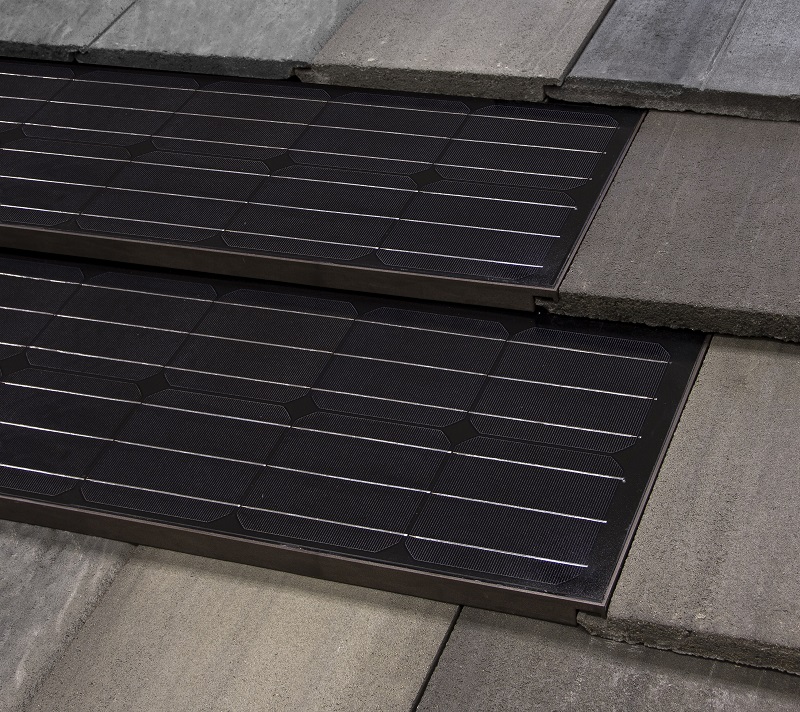
Closeup View of CertainTeed Apollo II Solar Energy Shields
Benefits of Solar Energy Shingles
Research and investment into improving and advancing the capabilities of solar energy shingles have continued largely to address the concerns that have hindered the adoption of raised-rack solar panels, such as: reduced curb appeal; bulkiness; managing two systems (roofing & solar panels), instead on one; dealing with technical obsolescence; confusing contracts and warranties; and questionable durability against natural elements, such as hail and wind.
The benefits of solar energy shingles consist of:
- One Roofing System with Dual Functionality
- Simplified Solution: One Vendor, One Project, One Price
- Improved Curb Appeal
- Ideal Solution for New or Replacement Roofs
- Installation Does Not Require Solar Specialists
- Long Lifespans & Warranties
- Comparable to the Combined Cost of a New Traditional Roof and Solar Panel System
- Larger Tax Incentive as the Full Project Amount can be used, as the Roof Replacement is Required for the Solar System
Solar shingles allow homeowners to install a fully integrated dual-function roof, one that protects the home against the elements, while also generating clean efficient energy.
Building-integrated photo voltaic products create a more elegant aesthetic rooftop that will not detract from the home’s overall curb appeal.
Although solar shingles can be placed on any condition of roof, manufacturers recommend the product for homeowners who are building a new home or in need of a roof replacement, as the product is essentially a “new, integrated solar roof”.
Solar shingles require no special tools or trade skills, as a professional roofer and electrician are all that is needed for the typical one-day installation.
Similar to solar panels, solar shingles have long lifespans, with warranties for power and durability averaging 25 years. Some manufacturers also offer solar shingle durability warranties that last for the lifetime of the property that they cover.
Comparison of Solar Shingles vs. Traditional Raised Rack Solar Panels
Rack-mounted solar panels are what consumers traditionally envision when someone mentions solar panels, as they are the most prevalent solar product on residential properties today.
Although solar panels have efficiency advantages over solar tiles, the panel mounts are often unattractive structures that detract from the appearance of a well-maintained property. Furthermore, solar panel systems must be constructed on a structurally sound or newer roof, since the weight of the panel structure can result in damage to an older, weaker roof.
Should you need to replace your roof, while the panel structure is in place, the entire solar system will need to be disassembled and re-assembled, while your new roof is being constructed.
Solar shingles are the ideal solution to the “need a new roof and want solar” conundrum. These smaller, thinner versions of solar panels are being sold as an integrated new roof plus solar capability with construction time occurring simultaneously for both products.
The cost savings of purchasing a new roof while installing solar capability means the cost advantage of solar panels alone is negligible, as the resulting project solves two issues.
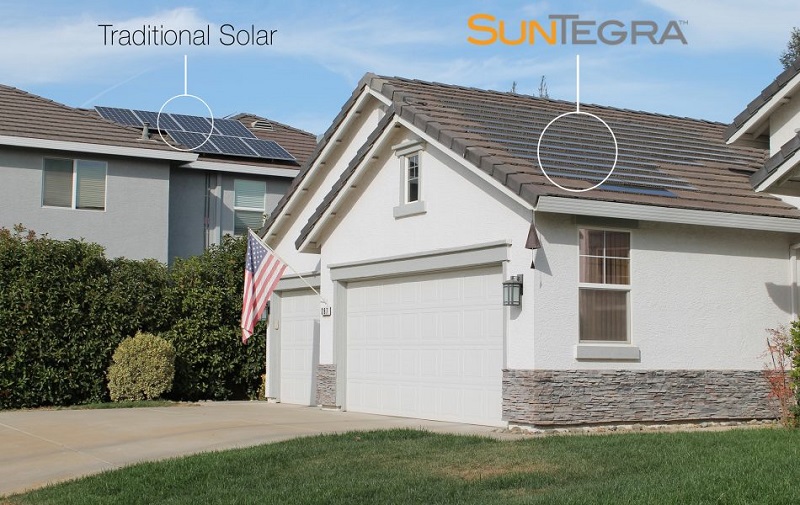
SunTegra Solar Shingles vs Solar Panel Residential Comparison
Below is a comparison of solar shingles vs. solar panels, based on parameters important to homeowners:
| Solar Shingles | Solar Panels | |
| Warranty | Can be transferred from property seller to buyer. If installer goes out of business, some shingle manufacturers will honor the warranty. | Some warranties may be non-transferable between owners. |
| Aesthetics | Improved curb appeal that integrates more elegantly with the roof profile. | Less attractive, bulky design that can detract from a home’s curb appeal. |
| Cost | More expensive than solar panels, if not needing a new roof. Can cost less, when needing a new roof and applying rebates and tax incentives. Tax incentives are larger as they can be applied toward the total cost (roof + solar panels). | Less expensive than shingles. Roof must be in good condition before installing panels. If you need a roof repair after the panels have been installed, disassembly and re-assembly will be required. |
| Energy Efficiency | Less efficient energy conversion than solar panels, with less output per square foot. | More efficient energy conversion than solar panels, with more output per square foot. |
| Installation Time | Faster than panels, with the end result delivering a new roof and solar capability. | Longer installation time. Must be installed by solar panel specialists. |
| Trade Professionals Needed | Installed by roofers, as the process is similar to constructing a roof, with the added trade, an electrician. | Requires solar panel specialists for installations, as well as for disassembly and re-assembly when replacing the underlying roof. |
A Brief History of Solar Energy Shingles
- NASA Patents Solar Energy Shingles
- Big Conglomerates and Other Pioneers Bow Out
- Elon Musk Boldly Enters the Fray – Results Don’t Match the Hype
- GAF Energy Launches a Roofing-Centric Approach
NASA Patents Solar Energy Shingles
Although only available commercially since 2005, solar shingles were first patented in 1977 by NASA:
“a solar cell shingle may be made up of an array of solar cells on a lower portion of a substantially rectangular shingle substrate made of fiberglass cloth or the like”
Big Conglomerates and Other Pioneers Bow Out
Much credit is given to DOW Chemical as the creator of solar cell shingles, despite the fact that pioneers such as Astro Power and PowerLight introduced solar cells, under the names SunChoice rooftop-integrated module and SunTiles respectively, in the early 2000’s.
However, despite these milestones, Astro Power filed for Chapter 11 bankruptcy and sold its assets to GE Energy in 2004, while PowerLight Corporation was acquired by SunPower Corporation in 2006.
Similarly, efforts by both DOW Chemical and BP Solar to develop a cost effective, residential solar shingle product that could be mass produced, also ended in failure.
Elon Musk Boldly Enters the Fray – Results Don’t Match the Hype
Enter Elon Musk and Tesla who purchased Musk’s cousins’ company SunCity in 2016 for $2.6 billion, as they ventured to throw their hat into the proverbial solar shingle “holy grail” ring. Five years later, Musk was quoted teasing an almost mythical solar roof product to the media stating:
“The goal is to make solar roofs that look better than a normal roof, generate electricity, last longer, have better insulation, and have an installed cost that is less than a normal roof plus the cost of electricity.” – Elon Musk
However, the resultant partnership of Tesla-SolarCity met with failure, as Tesla saw a 43% decrease in solar installations in Q4 2017 compared to their pre-partnership revenue. Tesla’s solar installation business further declined, and they were forced to move employees to other parts of their successful electric automobile business.
To add insult to injury, some of the Tesla-SunCity rooftops caught fire and an internal whistleblower, a former Tesla solar field quality manager, filed a complaint with the US Consumer Product Safety Commission, as part of a federal investigation.
According to the company, supply chain issues in early 2022 resulted in scheduling stoppage for new solar installations of their Solar Roof product.
GAF Energy Launches a Roofing-Centric Approach
In 2022, GAF Energy, a subsidiary of global manufacturer Standard Industries, announced a solar shingle product, Timberline Solar Energy Shingle. As part of one of the world’s largest manufacturers of roofing and waterproofing materials for residential and commercial buildings, GAF Energy approached the construction and design of its product from a roofing perspective rather than a solar perspective.
Timberline: The First Nailable Solar Energy Shingle
Timberline Solar Energy line is the first shingle product that can be nailed onto the roof, similar to how regular roofing shingles are installed. In fact, much of the Timberline Solar installation process mirrors regular roofing construction, such that a roofing crew, with roofing tools, are the required trade, along with an electrician for setting up the inverter.
Like most roofing projects the installation is faster, usually one day, than solar panel installations and does not require solar specialists or “solar-only” companies for set up.
Companies That Manufacture Solar Energy Shingles
The current list of leading manufacturers with viable solar shingle products are few, but their products are certainly gaining recognition and traction across the residential marketplace.
GAF Energy
GAF Energy, the market leader in integrated solar roof products since 2017, has recently launched their award-winning Timberline Solar Energy Shingle in 2022 which is touted as “A solar product that a roofer can install”.
It is the first and only product to achieve United Laboratories 7103 certification, which authorizes GAF Energy to install the shingles on residential roofs as both a roofing product and solar energy product.
Timberline Solar has quickly become a product darling in the BIPV category, receiving awards at both CES 2022 and IBS 2022. With its roof shingle comparable design, the product is more accessible for roofers, inspectors and post-installation servicing.
Timberline Solar Energy Shingles are targeted to homeowners who want solar, but have shied away from the bulky, unappealing solar products that had previously been available in the marketplace.
At the time of publishing, we were unable to confirm the average cost per square foot for GAF’s Timberline Solar Energy Shingles. However, we can share this cost guidance, based on a cost scenario shared by Martin DeBono, President of GAF Energy, to the Washington Post, which used DeBono’s home as the case study:
- Cost of a Traditional Roof: $28,000
- Cost of a Solar Panel System: $24,000
- Total Cost of the Two Systems Combined – no rebates applied: $52,000
- Solar Panel Rebate & Tax Incentive Savings: $8,000
- Total Cost After Savings of Two Systems Constructed Separately: $44,000
- Cost of a GAF Energy Solar Roof- no rebates applied: $42,000
- GAF Energy Solar Roof Rebate & Tax Incentive Savings: $12,000
- Total Cost After Savings of a GAF Energy Solar Roof: $30,000
- GAF Cost Savings without Rebates: $10,000 = ($52,000 – $42,000)
- GAF Cost Savings with Rebates: $14,000 = ($44,000 – $30,000)
Using this pricing scenario, we derived these simplistic cost comparisons for the scenario presented above as further guidance:
- A GAF Solar Shingle Roof (without savings & incentives) can cost approximately 50% more than a traditional roof, e.g. $14,000 more than a $28,000 traditional roof
- A GAF Solar Shingle Roof (with savings & incentives) can cost approximately 7% more than a traditional roof, e.g. $2,000 more than a $28,000 traditional roof
- A GAF Solar Shingle Roof (without savings & incentives) can cost approximately 19% less than a traditional roof with solar panels, e.g. $12,000 less than a $52,000 traditional roof with solar panels as separate projects
- A GAF Solar Shingle Roof (with savings & incentives) can cost approximately 32% less than a traditional roof with solar panels, e.g. $14,000 less than a $44,000 traditional roof with solar panels
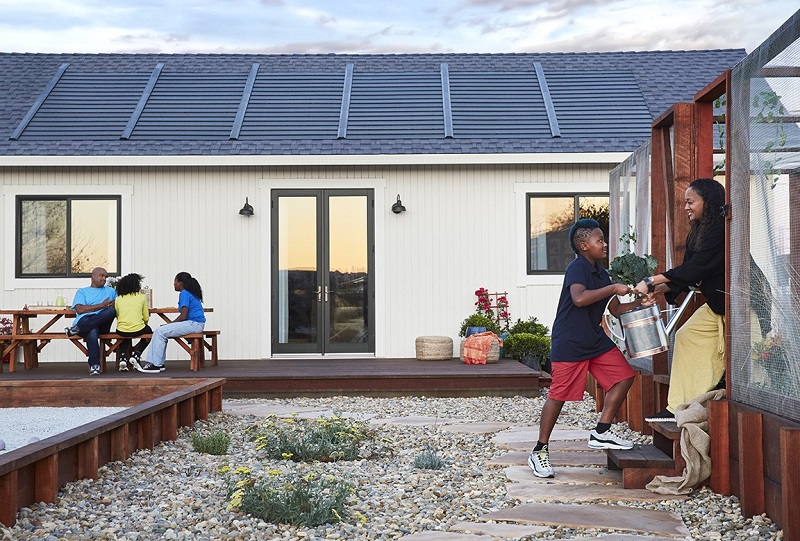
GAF Energy Timberline Solar Energy Shingles on One Story House with View from Backyard
- Product: Timberline Solar Energy Shingle
- Tile Warranty: 25 years
- Power Warranty: 25 years
- Maximum Power Output: 45 watts
- Wind Rating:ASTM D3161 Class F 130 mph
- Fire Rating: Class A (highest rating)
- Hail Rating: ANSI FM 4473 Class 3
- Cost Per Square Foot: Installation costs vary by market
- Directory of GAF Certified Roofing Contractors
- Verify a Contractor’s GAF Certification
CertainTeed
The Apollo II, by CertainTeed, was introduced in 2013, as the company’s next generation solar roofing system featuring integrated photovoltaic cells that are lightweight, durable, and resistant to wind uplift, with improved aesthetics. Apollo II can be integrated into an existing roof or installed into a new asphalt shingle roof. The BIPV product gives a seamless appearance when installed with surrounding traditional asphalt shingles.
- Product: Apollo II
- Tile Warranty: 10 years
- Power Warranty: 25 years
- Maximum Power Output: 45 watts
- Wind Rating: 110 mph Class A
- Fire Rating: Class A (highest rating)
- Hail Rating: ANSI FM 4473 Class 3
- Cost Per Square Foot: $27.37
- Apollo II Product Data Sheet
- Where to Buy Apollo II
- Directory of CertainTeed Roofing Contractors
- Homeowner Learning Center
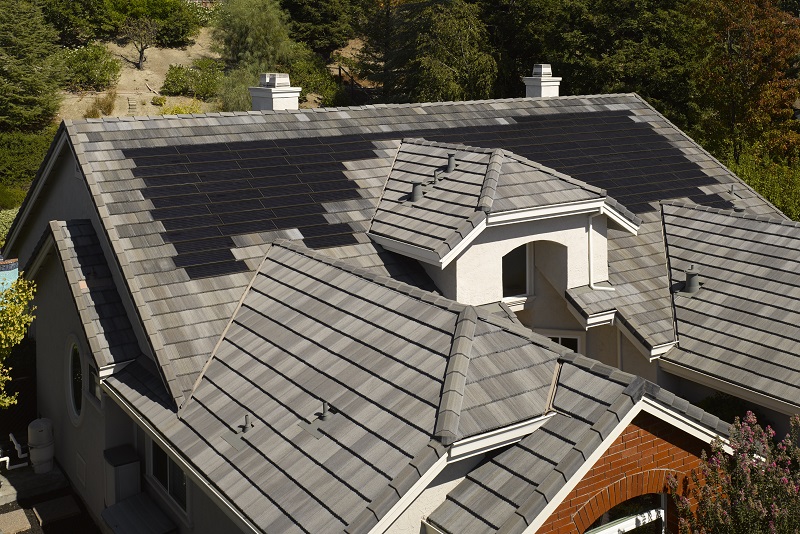
CertainTeed Solar Energy Shingles
Luma Solar
Luma Solar’s integrated solar roof systems are currently the only BIPV roofing system that can be upgraded to a next generation product. With one of the highest solar efficiencies of any integrated tile product, Luma Solar is one of the pioneers of solar shingle systems in North America. The company’s LSS80 is identical in appearance to traditional roof shingles, thus many installations are a combination of photovoltaic and regular shingles for a seamless aesthetic.
- Product: LSS80
- Tile Warranty: Lifetime
- Power Warranty: 25 years
- Maximum Power Output: 80 watts
- Wind Rating: TAS 125-03 Class F 200+ mph
- Fire Rating: ANSI/UL 790 – Class C
- Hail Rating: Miami-Dade Hurricane Rating – Class 5+
- Cost Per Square Foot: $38
- Luma Solar Shingle 80 Watt (LSS80) Product Data Sheet
- Luma Solar Photo Gallery
- Overview of Luma Technology
- Luma Certifications
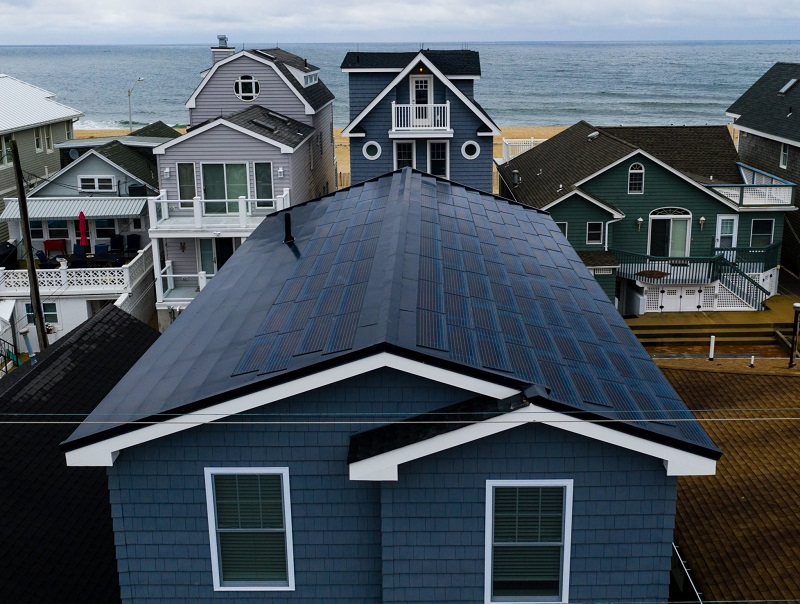
Loma Solar House by Beach
SunTegra
SunTegra Shingles and Tiles are considered interlocking products, as they attach directly to an existing roof and integrate with traditional roofing shingles and tiles, offering a low-profile, durable high-performance result. SunTegra’s solar roofing products are lightweight with integrated wiring, which increases the speed of roof installations, while reducing overall complexity.
- Product: SunTegra Solar Roof Shingles
- Tile Warranty: 10 years
- Power Warranty: 25 years
- Max Power Output: 105 to 114 watts (depending on shingle model)
- Wind Rating: ASTM D3161 Class F 130 mph
- Fire Rating: Class A (highest rating)
- Hail Rating: ANSI FM 4473 Class 3
- Cost Per Square Foot: $17.00 to $21.30
- SunTegra Solar Shingle Product Data Sheet
- SunTegra Photo Gallery
- Information for Homeowners
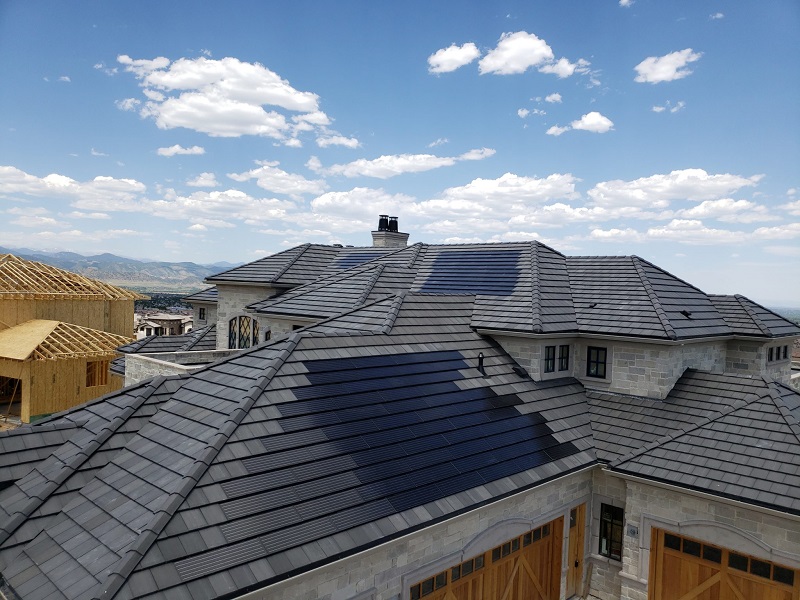
SunTegra Solar Energy Shingles on a New Home Build
Tesla Solar Roof
As previously, mentioned, due to production issues coupled with complications with the technology, Tesla’s Solar Roof is currently not accepting new installations. We include them for comparison purposes, as well as for their having generated a lot of interest in the solar energy shingle space.
- Product: Tesla Solar Roof
- Tile Warranty: 25 years
- Power Warranty: 25 years
- Maximum Power Output: 71.7 watts
- Wind Rating: ASTM D3161 Class F
- Fire Rating: Class A (highest rating)
- Hail Rating: ANSI FM 4473 Class 3
- Cost Per Square Foot: $23.94
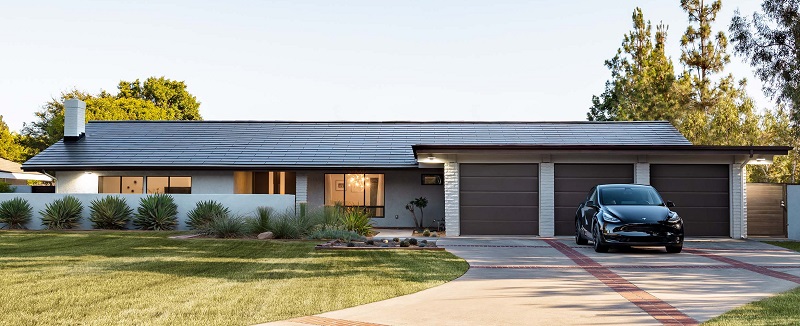
Tesla Solar Roof on Ranch House
Opportunities of Solar Energy Shingles
- The total cost of a roof that uses solar energy shingles can be used towards tax incentive programs, as the integrated system is necessary to receive solar energy
- Solar energy shingles that can be integrated into existing roofs offer a lower cost of entry for homeowners to try a solar solution for the first time
- GAF’s entry into the solar energy shingle space will help build awareness, speed up adoption rates and increase assurance that this technology will be supported for many years to come
Challenges of Solar Energy Shingles
- Conducting accurate apples-to-apples cost comparisons and full-cost-of-ownership of solar shingles remains challenging for homeowners, as there are still many variables that increase uncertainty (e.g. lifespan of solar energy shingles; lifespan of roofing tiles; durability and reliability of solar shingle roofs; projected energy savings to cover the investment outlay; ease and cost of maintenance; etc.)
- New solar shingle technologies come with risk (as do all types of new technologies), currently there is a relatively small install base with relatively short performance records
- GAF has not yet publicized pricing of their new Timberline Solar Energy Shingles (e.g. price per square foot) for homeowners to allow comparison with competing solutions
- Tesla’s highly publicized setbacks in the solar roofing space has fostered skepticism and doubt towards the long-term viability of solar shingles
- The percentage of current residential solar energy shingle installations remains tiny ( <1%) in comparison to the installed base of rack-mounted solar panels
- Risks pertaining to all types of residential solar energy solutions include: PV systems catching fire; roof leaks; and hail and/or wind damage.
Residential Solar Energy Resources & Tools
Roof Costing Resources
- HomeAdvisor Solar Panels Cost Tool
- HomeAdvisor Shingle Roofing Cost Tool
- 2022 Roof Replacement Costs
- GAF: Understanding Roof Costs
Solar Cost Savings Resources
- Google’s Project Sunroof Savings Estimator
- EnergySage Solar Panel Cost Savings Calculator
- SolarReviews Solar Panel Cost and Savings Calculator
- SaveOnEnergy’s Solar Power Calculator: Estimates & Savings
- NREL’s PVWatts® Calculator
- EERE Solar Rooftop Potential Resources
- What is a Sun Number Score and How is It Calculated?
- E.ON International Solar Calculator
Solar Incentive Programs
Recommended Reading
- What to Consider Before Purchasing a Solar Panel System for Your Home
- The New American Home 2022: A Courtyard Design for a Narrow Lot
- The New American Remodel 2022: A Mid-Century “Modernized” Preservation
- Building Technologies for Disaster Resistant Homes
- The New American Remodel 2021: Sustainable & Energy Efficient Beauty
- 10 Exceptional Products in The New American Home 2021
| Purgula is reader-supported. When you click on links to other sites from our website, we may earn affiliate commissions, at no cost to you. If you find our content to be helpful, this is an easy way for you to support our mission. Thanks! Learn more. |

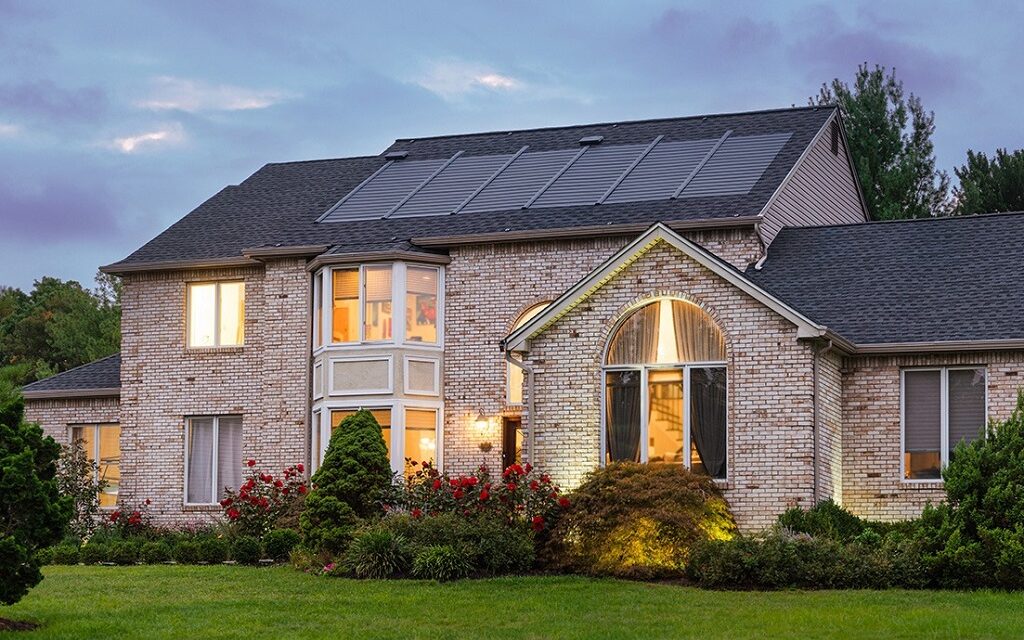






You have done a fantastic job putting this together and making it available to your readers. Thank you!
Roof repair can be costly especially when replacement is the only option. If damage, however, is not extensive, another option involves recoating the roof. Roofers have recommended a coating called Butyl Liquid Rubber.
Butyl Liquid Rubber conforms to any shape surface, flashing protrusion, vertical or horizontal, and can be applied easily with a paint brush or roller. It is catalyst based and cures by chemical reaction forming a self- leveling seamless membrane as it dries.